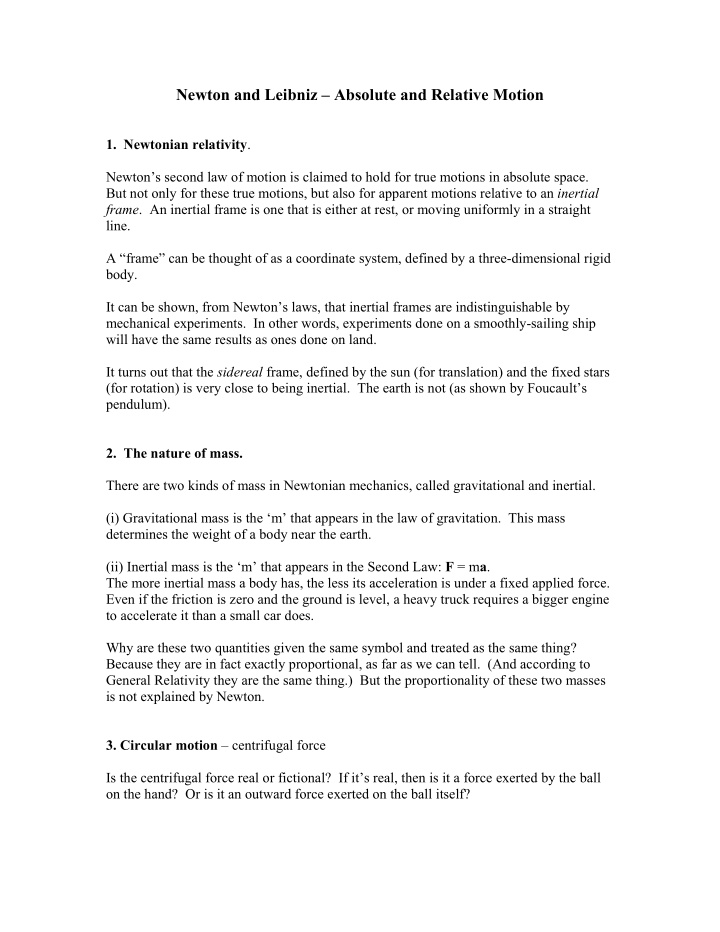



Newton and Leibniz – Absolute and Relative Motion 1. Newtonian relativity . Newton’s second law of motion is claimed to hold for true motions in absolute space. But not only for these true motions, but also for apparent motions relative to an inertial frame . An inertial frame is one that is either at rest, or moving uniformly in a straight line. A “frame” can be thought of as a coordinate system, defined by a three-dimensional rigid body. It can be shown, from Newton’s laws, that inertial frames are indistinguishable by mechanical experiments. In other words, experiments done on a smoothly-sailing ship will have the same results as ones done on land. It turns out that the sidereal frame, defined by the sun (for translation) and the fixed stars (for rotation) is very close to being inertial. The earth is not (as shown by Foucault’s pendulum). 2. The nature of mass. There are two kinds of mass in Newtonian mechanics, called gravitational and inertial. (i) Gravitational mass is the ‘m’ that appears in the law of gravitation. This mass determines the weight of a body near the earth. (ii) Inertial mass is the ‘m’ that appears in the Second Law: F = m a . The more inertial mass a body has, the less its acceleration is under a fixed applied force. Even if the friction is zero and the ground is level, a heavy truck requires a bigger engine to accelerate it than a small car does. Why are these two quantities given the same symbol and treated as the same thing? Because they are in fact exactly proportional, as far as we can tell. (And according to General Relativity they are the same thing.) But the proportionality of these two masses is not explained by Newton. 3. Circular motion – centrifugal force Is the centrifugal force real or fictional? If it’s real, then is it a force exerted by the ball on the hand? Or is it an outward force exerted on the ball itself?
If we transform Newton’s second law to a rotating frame, and we find the centrifugal and Coriolis terms appear. Physicists, as opposed to high school teachers, tend to regard inertial forces as real. After all, they’re indistinguishable from gravity. And they can squash you flat. But a Newtonian must regard them as fictional. Note that, in the rotating frame, the ball is “stationary” and in force equilibrium. 4. Newton’s bucket. Acceleration (including rotation) is absolute. So velocity and position must be absolute as well. 5. Leibniz’s criticisms. The Principle of Sufficient Reason. If space is completely uniform, then there’s no reason to put the universe’s matter here rather than there. Or stationary rather than moving. Space is just a type of relation between material bodies. Clarke: The will of God is a sufficient reason. (Seems to mean cause here.) Leibniz: our notion of space generated by rigid bodies. One object stands in a certain relation to a rigid body (e.g. the earth). Later, another object stands in the same relation. We then say they both stood in the “same place ”. Leibniz never responded to the rotating bucket argument. He merely argued against the conclusion. The challenge is this: absolute space seems essential to Newtonian mechanics, since his laws hold only in inertial frames. So Leibniz really owes us another system of mechanics that does at least as well, but which doesn’t require the hypothesis of absolute space and time. This he doesn’t provide. 6. Leibnizian mechanics What could Leibniz have said? Basically, he could have introduced inertial forces as real, rather than fictional. (I) When A accelerates relative to B, B exerts an inertial force on A proportional to the product of their masses, and the relative acceleration. The direction of this force is opposite to the relative acceleration. (Anticipating an aspect of relativistic electromagnetic theory, Leibniz might have claimed that this inertial force on A only exists in the rest frame of A. It arises from accelerating through B’s gravitational field.) Thus, when a body A accelerates relative to the sidereal frame, it accelerates relative to a lot of matter, and those little forces add up to a substantial inertial force, opposite to the acceleration.
(II) Revise Newton’s Second Law to state: Every body is in force equilibrium in its own rest frame. Thus, when a body feels an applied force, it has to accelerate relative to the sideral frame, to just the extent required for this force to be balanced by an inertial force. The more massive the body, the less acceleration is required, since the inertial force is proportional to the gravitational mass. This also explains the indistinguishability of gravitational and inertial forces.
Recommend
More recommend